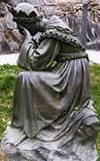Progressivism in the Church
Church Revolution in Pictures
Photo of the Week
/878_Vir1.jpg)
Base Communities promote pagan idols
Above, you see the official poster inviting everyone to the XI Continental Meeting of the Christian Base Communities in Central and South Americas. It took place in Guayaquil, Ecuador, from March 9 to 12, 2020. It was sponsored by the Catholic Church.If we pay attention to the scene in the picture, in the foreground we see two open hands and a face of an Indian emerging from the waters. It is not clear whether that person is a male or a female.
The central long-haired faceless figure in the scene – again unclear whether a man or a woman – is sitting under a tree and surrounded by six seated persons who hold different objects in their hands as if offering them to the central person; one old man in a blue shirt bows in a position of veneration. In the center of that group we also see an animal – a lamb, a dog or a monkey? – in a resting position.
At left, we see six persons singing and dancing to the rhythm of a drum beaten by a man dressed in yellow. Below them, a child has turned around and seems to be leaving the scene, following the steps of someone whose foot only appears.
At the right, we see persons jumping in euphoria; one woman in a beige and green dress brings gifts in a basket and another person, behind her, is entering the scene playing a flute.
Intertwined in the branches and leaves of the tree are many animals, from the top right clockwise: a toucan, a butterfly, a serpent, a capybara, a turtle, an octopus, a coyote and an owl.
Behind everything is what appears to be a lake; behind it to the left, a hill covered with vegetation is illuminated by the moon; at right, a steep rocky hill is warmed by the sun. A group of butterflies flies atop the tree.
The whole scene seems to be a representation of an Amazonian Mass. The priest or priestess at the center breaks a loaf of bread, and all the dancing and singing figures would be participants in an inculturated liturgy, like those that Pope Francis encouraged in Querida Amazonia.
What is remarkable is the presence of the figure in the foreground emerging from the waters.
According to Inca mythology, where we find Pachamama as the goddess earth, in this scene two of its other gods seem to be represented.
1.Vira Cocha, first row below, is the god creator; he came from the waters of Titicaca Lake in Peru. If this was indeed what the painter wanted to represent, then we would have the god Viracocha "blessing" the inculturated liturgy of the new Amazonian Church;
2. Mama Cocha, second row below, is a goddess of the waters. If the painter intended to portray this goddess, then we would have a counterpart of Pachamama. The latter is the goddess of earth, Mamacocha or Cochamama is the goddess of the waters.
In either hypothesis, we have the new Amazonian Church adopting one more element of Inca idolatry. Now it has Pachamama and Cochamama.
/878_Vir2.jpg)
Photos from the Internet

Posted March 29, 2020
___________________________
________________________










